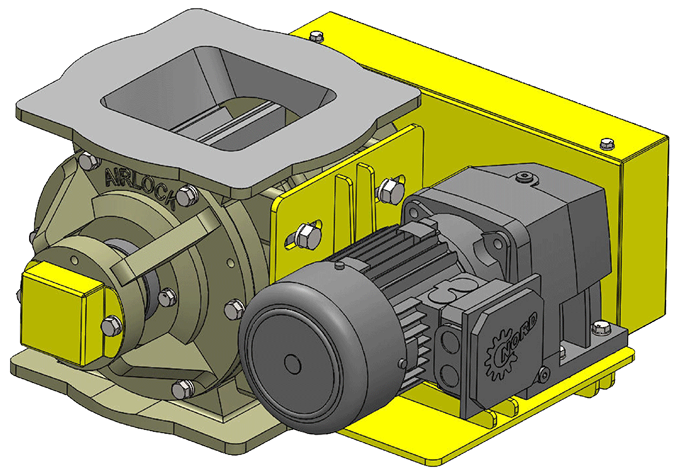Airlock Sizing Program

Engineering Confidence.
Delivering Value. That’s the Airlock Genius Promise.
To accurately size a rotary airlock valve based on material flow, it's essential to consider several key factors, including the desired conveying rate, material bulk density, valve efficiency, and rotor speed. Here's a step-by-step guide to help you through the process
Sizing Procedure
Step-by-Step Procedure for Rotary Airlock Valve Sizing
Once the sizing calculator provides the required valve volume capacity based on your input parameters, refer to the table below to identify the optimal combination of airlock size and valve RPM that meets or exceeds your requirement.
Example:
Let’s say your input parameters are:
- Material Flow Rate (R): 10,000 lbs/hr
- Bulk Density (D): 50 lbs/ft³
- Valve Efficiency (E): 0.65
- Using the sizing formula or calculator, you get:
- Required Valve Volume Capacity = 307.69 ft³/hr
Next, refer to the sizing table below to find the smallest valve that can handle this volume at a practical operating speed — typically around 20 RPM.
In this example, an 8-inch airlock operating between 17 to 20 RPM would fulfill the requirement effectively.
✅ Tip: Always account for potential increases in future demand. It’s often advisable to select a valve with slightly higher capacity to ensure long- term scalability and performance.
| Airlock Valve Capacity (Cubic Feet/Revolution) | |||||||
|---|---|---|---|---|---|---|---|
| Valve RPM | 6 | 8 | 10 | 12 | 14 | 16 | |
| Cubic Feet / Rev. | 0.15 | 0.31 | 0.58 | 1.11 | 1.63 | 2.50 | |
| Valve Capacity in Cubic Feet / Hr. | |||||||
| Valve RPM | 10 | 93 | 188 | 349 | 666 | 978 | 1502 |
| 11 | 102 | 207 | 384 | 733 | 1076 | 1652 | |
| 12 | 111 | 226 | 418 | 799 | 1173 | 1802 | |
| 13 | 120 | 245 | 453 | 866 | 1271 | 1953 | |
| 14 | 130 | 264 | 488 | 933 | 1369 | 2103 | |
| 15 | 139 | 282 | 523 | 999 | 1467 | 2253 | |
| 16 | 148 | 301 | 558 | 1066 | 1564 | 2403 | |
| 17 | 157 | 320 | 593 | 1132 | 1662 | 2553 | |
| 18 | 167 | 339 | 628 | 1199 | 1760 | 2704 | |
| 19 | 176 | 358 | 663 | 1266 | 1858 | 2854 | |
| 20 | 185 | 377 | 697 | 1332 | 1956 | 3004 | |
| 21 | 194 | 395 | 732 | 1399 | 2053 | 3154 | |
| 22 | 204 | 414 | 767 | 1466 | 2151 | 3304 | |
| 23 | 213 | 433 | 802 | 1532 | 2249 | 3455 | |
| 24 | 222 | 452 | 837 | 1599 | 2347 | 3605 | |
| 25 | 231 | 471 | 872 | 1665 | 2445 | 3755 | |
| 26 | 241 | 490 | 907 | 1732 | 2542 | 3905 | |
| 27 | 250 | 508 | 942 | 1799 | 2640 | 4055 | |
| 28 | 259 | 527 | 976 | 1865 | 2738 | 4206 | |
| 29 | 268 | 546 | 1011 | 1932 | 2836 | 4356 | |
| 30 | 278 | 565 | 1046 | 1999 | 2933 | 4506 | |
Actual pocket fillage varies based on application. For optimum selection, please contact us; For feeding applications, 10 to 20 RPM generally provides most uniform discharge of product at greater fill efficiency
selection
